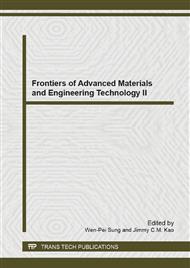p.338
p.342
p.346
p.352
p.356
p.362
p.366
p.370
p.374
Synthesis and Electrochemical Characteristics of Li3V2(PO4)3/C Cathode Materials for Li-Ion Batteries
Abstract:
Li3V2(PO4)3/C composites were synthesized by sol-gel routine with citric acid as chelates and carbon sources at different preparation conditions , meanwhile saccharose has been used to separate the Li3V2(PO4)3/C particles When it dissolve out in the process of solvent volatilizing. The effects of different preparation conditions and the existence of saccharose on crystal structure and electrochemical performance were characterized by XRD, SEM and electrochemical workstation. The results shows that all the Li3 V2 (PO4)3 samples are pure monoclinic phase; The crystal structure and the lattice parameters remain unchanged in different conditions, but it has effects on their average size of particles. The existence of saccharose suppress the growth of particle size and particle aggregation, and then affect electrochemical performances indirectly. In addition , the cycling performances of all samples displayed well at 3.0~4.2V on low rate charge/discharge, but the rate performance become worse with the increasing of average size of particle and particle aggregation and the capacity reduces seriously on high rate charge/discharge.
Info:
Periodical:
Pages:
356-361
Citation:
Online since:
April 2014
Authors:
Keywords:
Price:
Сopyright:
© 2014 Trans Tech Publications Ltd. All Rights Reserved
Share:
Citation:


